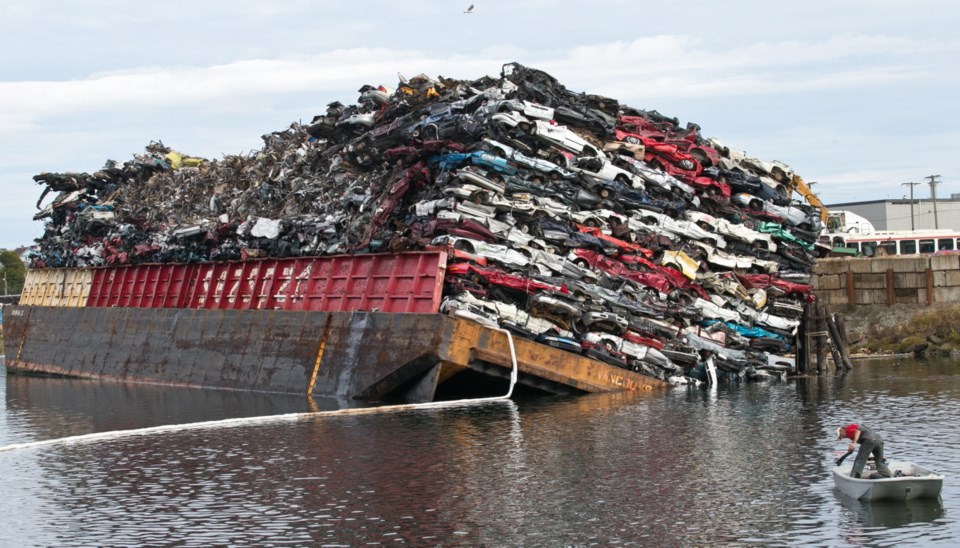More crushed cars and scrap metal toppled into the Gorge Waterway on Wednesday as a crane tried to complete the tedious task of moving cars from one barge to another.
As crews work to stabilize the barge, it will likely be weeks before the cars at the bottom of the waterway are recovered, according to the Ministry of Environment.
A car that was dangling precariously over the side of the scrap metal heap fell into the water as cars on top of it were moved.
Just before that, the crane had a hold of a large chunk of scrap metal and was swivelling over to another barge when the load crashed into the water.
Some people watching from the bridge of the Selkirk Waterfront development remarked that the operation looked like an arcade game where an overhead claw tries, often unsuccessfully, to latch onto a prize below.
Once the barge has been stabilized and there’s no risk of more cars falling off, the barge will be inspected by a naval architect to determine if it’s seaworthy, said Laurie Boyle, an emergency response officer with the Ministry of Environment.
When the barge can be moved, an underwater survey will take place to determine how many cars are on the bottom of the waterway, Boyle said.
Dozens of cars fell into the water on Friday after the barge, owned by Seaspan, tipped from one side to the other.
While a sheen of fuel covers the water, the Ministry of Environment said the environmental damage is minimal because metal-recycling companies are required to empty fuel from vehicles.
Schnitzer Steel, the company transporting the scrap metal, will hire a contractor who will use grapple hooks and magnets to recover the cars and parts.
Schnitzer Steel has not yet identified the cause of the accident.
“We’re moving as quickly and at the same time as carefully as possible,” said Mike Geoghegan, a media spokesman for the company. “The priority is removing any materials that are a navigational hazard.”
WorkSafe B.C. issued a stop-work order for Schnitzer Steel, located on David Street in Rock Bay. Both Transport Canada and WorkSafe B.C. have the power to levy fines if it’s determined the operation was unsafe.
A naval architect is required to inspect the barge before it’s loaded and then before it moves the cargo. Transport Canada sets out regulations for how cargo is loaded onto barges. The agency said its role “is to ensure that Canada’s waterways provide safe navigation to marine vessels, and are free of ship-source pollution. Individual vessel owners remain responsible for their property.”
Transport Canada is reviewing the loading procedure, the Ministry of Environment is looking into whether any environmental regulations were violated and WorkSafe B.C. is conducting a workplace safety inspection.
A crane operator on top of the barge when it tipped was not injured.



